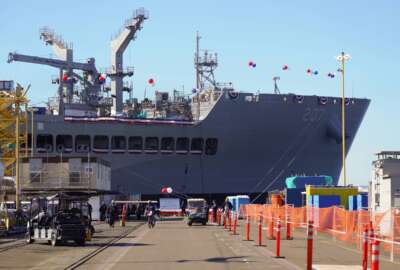Air Force reducing energy consumption in the air, on bases
The Air Force is hungry for energy like no agency in the federal government. The service\'s top energy official says they\'re trying to have a smaller appetite ...
wfedstaff | June 4, 2015 4:28 pm
The Air Force uses more energy than any other agency in the federal government, and it’s not likely to give up the top spot any time soon. It flies some 900 flights every day around the globe, not counting its wartime missions, and it’s responsible for running installations all over the world.
Nonetheless, the service has made big strides in cutting its energy consumption. Since 2006, the Air Force cut its consumption of jet fuel by 2 percent during a period when it was tasked with carrying more not less cargo. On its bases, it’s reduced the amount of electricity it consumes by 15 percent, compared with 2003 figures.
While some of the energy savings are the result of up-front investments in energy-saving technologies, many are simply the result of rethinking the way the Air Force manages its operations, said Kevin Geiss, the Air Force’s deputy assistant secretary for energy. 
Some of the solutions have been as simple as allowing the Air Force’s huge cargo planes to hold on the ground for longer periods so that they can be filled with more cargo before departing for their destinations.
“We as civilians, as well as the military, have become accustomed to just-in-time logistics, and that’s fine,” Geiss said. “But can you wait four hours? Then we can bring those four tons all at the same time and do it more efficiently.”
More efficient use of airspace
Other changes include software-assisted alterations to aircraft flight paths so that they make more efficient use of airspace, work to get diplomatic clearances to fly through the airspace of nations that have thus far prohibited certain types of U.S. military over flights and even regular scrubdowns of jet turbines to remove grime that can reduce engine performance.
All told, the Air Force expects procedural changes in its Air Mobility Command to save $700 million worth of jet fuel over the next five years.
On its installations, Geiss said the Air Force produced or procured 6 percent of its energy from renewable sources last year. In some locations, solar makes sense, others are more suited to wind generation.
But he said there are often more important considerations than geography. The Air Force must navigate a complex web of varying local factors dealing with land use regulation, renewable energy incentives and relationships with local utility providers.
Some preliminary successes in navigating that web include Los Angeles Air Force Base, where the Air Force partnered with the State of California to convert its entire fleet of general-purpose vehicles to all-electric cars and trucks. In another case, the Air Force partnered with the Army in a Massachusetts to install windmills that support an environmental reclamation project.
But Geiss said many of the energy efficiency gains the Air Force has seen have come from the bottom up, a process his office working to encourage by partnering with the Air Education and Training Command to instill energy considerations in to the service’s training and doctrine.
Training to rethink energy usage
In one instance, airmen in charge of painting C-5 cargo planes at Warner-Robins Air Force Base, Ga., figured they could save a lot of electricity by shutting down the huge temperature and environmental control systems needed to paint the aircraft during periods when there was no plane in the paint booth. The result was $400,000 per year in savings, Geiss said.
Also, the Air Force has just rolled out an energy awareness module on its online Air Force Portal, designed to help airmen think about how to save energy during the course of their individual jobs.
“If you’re an aircraft maintainer, energy means something different to your job than if you’re a medical technician,” he said. “We’re trying to distill this down to, ‘what does this mean to me in my job?’ We’ve also updated our Air Force policy directive as it relates to energy management, and we’re requiring that every installation in the Air Force has a process and a governance for how they deal with energy on their installation.”
RELATED STORIES:
Air Force seeks to consume-not pay for the development of–biofuels
Copyright © 2024 Federal News Network. All rights reserved. This website is not intended for users located within the European Economic Area.
Jared Serbu is deputy editor of Federal News Network and reports on the Defense Department’s contracting, legislative, workforce and IT issues.
Follow @jserbuWFED






